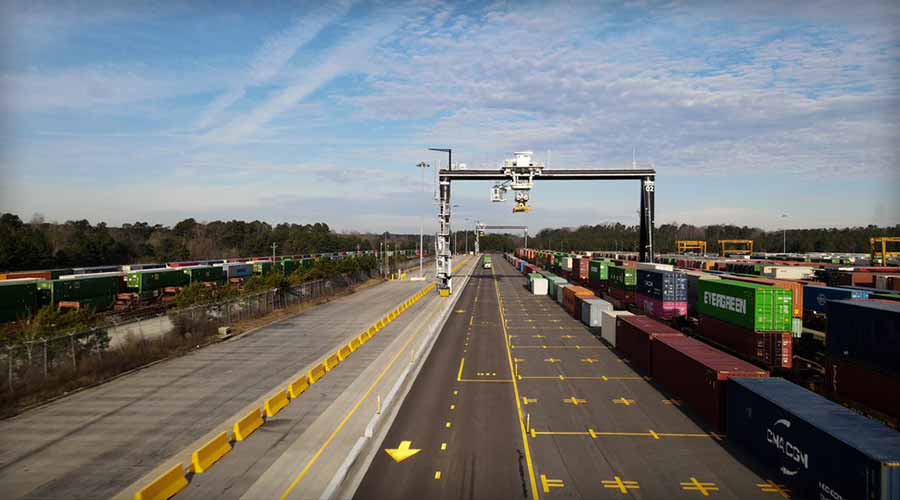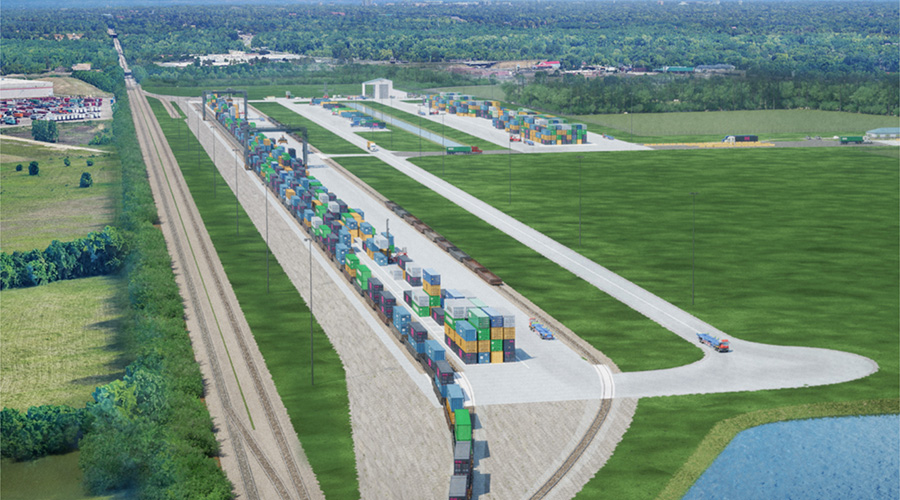New cranes at NS' Austell intermodal site to double throughput
1/27/2023
By Grace Renderman, Associate Editor
Norfolk Southern Railway is putting the finishing touches on the first major capacity project to take place at its Austell, Georgia, intermodal terminal: the addition of six new fully electric cranes.
In the works for four years, the project is scheduled for completion by year's end. Adding the cranes will turn the Austell site into a partial stacked-container facility, which will help double throughput to 100,000 containers annually. Since the terminal opened in 2001, it’s been a solely wheeled-container operation.
While crews worked to install the new cranes, they removed 400 parking spaces dedicated to international cargo to accommodate the stacking operations, says Brad Carper, director of intermodal and automotive terminal operations since last year.
The combined maximum capacity of the two tracks underneath the stacking module is about 2,400 containers.
 The fully electric cranes are expected to be operational by year's end. Norfolk Southern Railway
The fully electric cranes are expected to be operational by year's end. Norfolk Southern Railway The top project priority is ensuring the driver experience at the terminal is as efficient and painless as possible, Carper says.
“It provides the framework for growth not just at Austell, but at other terminals also, where we can use this model’s components … at other facilities,” he says. “Our intermodal facilities, in many cases, are landlocked. So, if you can’t go out, you have to go up.”
The Austell site regularly ranks second in terms of annual lifts among all the railroad’s intermodal terminals, just behind Chicago’s 47th Street terminal. Austell has averaged between 520,000 and 550,000 lifts per year since 2019. With the new stacking capabilities, annual lifts will reach the 650,000 mark, Carper says.
The first of their kind
Manufactured by Kuenz Cranes, the fully electric cranes cost around $3.5 million each and are the first of their kind in North America, according to a NS press release. They’re part of a sustainability initiative to replace diesel-hydraulic cranes with diesel-electric units — or in the case of Austell, fully electric units, says Chief Sustainability Officer Josh Raglin.
“We’re continuing to … look at our operations and plan out our capital budget strategically as we think about equipment replacements,” Raglin says.
In 2021, the railroad began to replace diesel-hydraulic machines with diesel-electric machines (including cranes and other heavy equipment), which helped reduce fuel consumption by 75%. In the switch, NS will replace another 10 machines across the network and add three more to accommodate intermodal volume growth, says Ingrid Crafford, senior director of assets and optimization.
Hydraulic-powered machines can be unreliable because they can’t automatically detect a failure point during operation, which makes these hybrids — which include sensor technology and other higher-tech features — much more attractive, she adds.
Diesel-electric cranes use regenerative braking, which helps recapture some of the energy spent hoisting containers and put it back into the machine’s own batteries. Fully electric units also use this feature, though to a lesser extent. Some of the railroad’s hybrid machines mainly run off battery power and use diesel fuel as a backup.
“We can pull the plug and they’ll operate for about 30 minutes without the electric cable,” Crafford says.
NS will continue to source diesel-hybrid cranes from Kuenz, as well as Konecranes and Knox Kershaw Inc., Crafford says.


